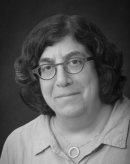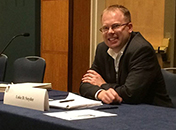The Next Chapter – Issue 4


Reflections and Predictions
There’s something about the close of a year that inspires some reminiscing,
especially when the year has been a good one. We’re proud of a number of
things:
- The wins: The TMA Transaction of the Year Award for 2013, which kicked off our year, and an M&A Atlas Turnaround Award for Oreck and for AgFeed. And a big emotional win for us is our recognition as one of theOutstanding Turnaround Firms – 2014 by Turnarounds & Workouts.
- The big deal: We took on one of the biggest bankruptcies ever filed, representing the unsecured bond holders on the regulated side of the largest bond default in history and the eighth-largest Chapter 11 case in history, Energy Future Holdings.
- The plan: Our three-year business plan, which we set in January, includes making sure we attract, retain and reward the brightest, most entrepreneurial and most creative professionals in our space. Having the firm comprised of this talent makes us a much easier choice for someone who doesn’t already know us. It gets to the answer of the question “Why should I hire this mega firm and spend four or five times more money in fees, when I can hire Gavin/Solmonese, who is literally right down the street from the courthouse, has credibility with the attorneys, has the talent, knows the courts, and is recognized in the industry?”
- The rankings: We’ve been ranked throughout 2014 in The Deal Bankruptcy League Tables as one of the busiest crisis management firms in the country. Quarter after quarter, our firm and our case team members are ranked busiest in terms of numbers of engagements. Plus, we are near the top of the lists in terms of ranking by dollar value of debt in the cases we manage.
- The growth: We’ve advanced the Gavin/Solmonese footprint across the country with the opening of our Chicago office late last year. Our next office will probably be New York City to support our growing New York-based team, and then following that will likely be Minneapolis, the city which Ted refers to as his “happy place.”
This momentum sets the tone for 2015, when we expect to be busier than ever. The election changed control of the Senate and has reset the political landscape ahead of the 2016 presidential campaign (for more insight, read A Look Ahead: Politics and the Economic Landscape in this newsletter.) Here’s how we see the near future:
- On the road toward the 2016 election, elected and regulatory officials are making decisions that will impact our clients’ competitiveness or complicate their missions. Our public affairs practice is already busy with grassroots and organizational projects to help our clients continue to build their reputations and effectively engage with their stakeholders around the world.
- The new political landscape will result in one of two scenarios: either there will be more loan defaults, more loans going into workout that will increase bankruptcy activity, or re-financings and troubled loan restructurings will increase. Our corporate recovery team is already geared up to manage the bump in activity on either platform.
Thanks for reading this issue of The Next Chapter. We appreciate your interest in our firm, and in better understanding how to create value for your investors, creditors and employees. Contact us. We’d love to hear from you.
Ted & Joe
10 (or more) Questions: Janice Grubin, Esq.
Janice Grubin, Esq., a shareholder in LeClairRyan’s Bankruptcy and Creditor’s Rights practice, has years of experience with distinctive cases of national significance. Grubin, who is recognized by Super Lawyers as a “Top Female Attorney in New York” for 2015, serves as an elected and appointed chapter 7 and chapter 11 trustee in cases pending in the Eastern, Southern and Northern Districts of New York. She spoke with Ted Gavin about the important influences in her life and what inspires her to help younger professionals achieve their professional best.
Thinking back to the outset of your career, what was your first job?
I accepted a two-year clerkship with a newly-appointed bankruptcy judge in upstate New York, where I was exposed to an abundance of consumer cases and some interesting chapter 11 cases. I had no bankruptcy training in law school, so I taught myself the Bankruptcy Code in between reading the classics, such as Anna Karenina and Buddenbrooks, that first year. After my clerkship, I joined Day, Berry & Howard (now Day Pitney) in Connecticut, where I worked on the historic Public Service Company of New Hampshire bankruptcy case.
Was that case a memorable experience?
It was in many ways. PSNH was a mega-case pending in New Hampshire before the late Judge James Yacos, a knowledgeable and affable bankruptcy jurist. Numerous factions, represented by sophisticated lawyers, vied for control of the debtor, and there was an ever-present political undercurrent every day. We travelled on the client’s small propeller plane between Connecticut and New Hampshire during the disclosure and confirmation hearings because the lead litigator liked to sleep in his bed every night. I remember some hair-raising flights in bad weather! And the case was noteworthy because it resulted in the issuance of a landmark exclusivity decision and Northeast Utilities, our client, emerged as the successful purchaser of PSNH in a chapter 11 hostile take-over, with the confirmed plan going effective in a two-step process due to the regulatory requirements.
Much has changed in the professional landscape, including the impact of sexuality issues on career development, hasn’t it?
It has. What is still the same though is that, as a young lawyer, you are judged by your peers and your firm’s partners on just about everything. When I started practicing in 1987, non-traditional sexuality was best left hidden.
How did that environment impact your early career?
I was not comfortable telling people that I was gay, so I kept my personal life quiet. I attended firm functions solo and it was a lonely time. I suppose that people wondered about my private life, and may have made some judgments as a result.
I understand that these experiences have been instrumental in how you relate to younger professionals today.
Yes. I feel obligated to demonstrate that sexuality is not a roadblock to young professionals achieving their potential in a business setting. Over the last decade, as the legal climate has changed, so has the professional climate. In turn, today, I am open about my sexual orientation. I have become active in LeGaL and serve on its Board, chair its Judiciary Committee and participate in its Partners Group. And I’m involved in the WorkOUT group in New York City (WorkOUT is an affinity group of LGBTQ turnaround and restructuring professionals and is centered in New York, NY). I am committed to working actively to bring social justice and equality to the LGBTQ community.
These experiences have also had a big part in how you conduct yourself as a role model, right?
Yes. I am a firm believer in proving by example. So, for any person who might hesitate to engage me because of my sexual orientation or my gender, I am very conscious of striving to be the best and most ethical attorney I can be in order for them to see that my gender or sexuality has nothing to do with my professional performance.
What were your parents’ careers?
My dad was a flight engineer for Pan Am and my mom was a secretary for the Jewish Welfare Board in Manhattan and then for an insurance broker. She later bought the brokerage and ran the business from our home.
How did their careers influence you?
I was – and am — so very proud of both of them.
My dad was always flying to exotic and faraway places and I could see that he was respected and trusted by the flight and ground crews. I also remember him studying hard for his flight tests every six months or so. This all made a big impression on me as a young girl. We traveled widely as a family and I grew to appreciate and be open to different cultures, people and experiences.
My mom is a self-starter, no-nonsense, very direct kind of person and basically raised my sister and I since my dad was away a lot. I saw how well her people skills served her as she dealt with clients who would call in the middle of the night in an emergency, such as a car accident or house calamity. She was always personable and practical, and I like to think I bring all of those traits and her emotional intelligence to my daily interactions with others.
You were counsel for the debtor in a chapter 11 case some time ago, in which the first 524(g) plan in the country was confirmed. What were the circumstances that led to this conclusion and what do you believe was its legacy? (Note: Section 524(g) of the Bankruptcy Code deals, broadly, with injunctions against creditor actions against a post-confirmation Debtor and related entities in mass tort (asbestos) cases)
The asbestos bankruptcy statute had just been enacted and Keene Corporation was the first case to confirm, in 1996. Mediation directed by the bankruptcy judge resulted, ultimately, after many, many negotiations, in the approval of the 524(g) plan. The legacy is that 524(g) is now part of the asbestos debtor’s toolbox and used as a model for non-asbestos mass tort cases.
After spending the first part of your career in mega-cases, you’ve spent the balance of your practice in smaller, middle-market cases and niche roles. How did that change come about?
I was fortunate to be involved in large cases at the start of my career, and found the big stakes and the big dollars fascinating. As my skills and contacts developed, I realized that it was critical to have a book of business to establish my professional independence. Smaller cases and interesting roles were where my business came from. This was an organic process as a result of years of careful internal and external networking.
Contentious cases seem to find you. How did that dynamic come about?
Well, first of all, bankruptcy is the place for contentious cases, isn’t it? From the beginning of my career I have had contentious cases. And the trustee cases are particularly contentious, by their very nature, since they often involve the involuntary displacement of management.
My first contentious case that got noticed was, in 2004, my first trustee case. I served as the chapter 11 operating trustee for three closely-held real estate corporations that owned and operated rent-stabilized apartment buildings in Brooklyn, where over 600 people lived and worked. Notwithstanding a difficult owner, demanding tenants and buildings that suffered from years of deferred maintenance, I achieved a successful result: the buildings were sold to an experienced owner/operator at a price that generated a 100 percent distribution to the unsecured creditors. That case launched my reputation as a tough attorney who could handle difficult situations.
My subsequent trustee cases, involving Dunkin Donuts’ franchisees, a gourmet grocery near Ground Zero and a failed non-profit research institute, were, and are, just as challenging, and required every bit of business and legal acumen, emotional intelligence, patience and relentless hard work that I could and can muster, and reinforced that reputation.
The judge’s opinion on that real estate case included a memorable statement, didn’t it?
Yes. In commending my conduct in the case, Bankruptcy Judge Feller wrote that “[d]ue process does not require the Trustee to be clairvoyant.” (In re Sudano Corp., 391 B.R. 678, 689 (Bankr. E.D.N. Y. 2008), aff’d, Bongiovanni v. Grubin, 2010 WL 3927042 (E.D.N.Y. Sept. 30, 2010), aff’d, Bongiovanni ex rel. Bongiovanni v. Grubin, 451 F. App’x 53 (2d Cir. 2011), cert denied, 133 S.Ct. 137 (2012).
In the last few years, you’ve spent a lot of time dealing with healthcare restructurings in rural New York State. How is restructuring a hospital in St. Lawrence County different from a failed hospital in New York City?
The biggest difference is that, in urban areas, the issue is quality of care and, in rural areas, the issue is availability of care. Therefore, the restructuring must take these different realities into account. A rural hospital, with a smaller population to serve over a larger geographic and often transportationally-challenged area, has to be able to cover operating expenses and still have enough working capital to attract high-quality physicians. This is a different setting than where you have a community hospital with the academic teaching hospital a 20 minute subway or cab ride away. These are different challenges with the same basic goal of quality of care.
What’s next for you?
I am proud to take an active role in further expanding the robust insolvency practice at LeClairRyan, with an emphasis on fiduciary roles and representations and distressed healthcare. In the short term, I’m enjoying the holiday season in New York and Connecticut with my friends and family, reading that extra crime fiction novel, listening to the new Foo Fighters, and opening up some special wines.
A Look Ahead: Politics and the Economic Landscape

Unlike a natural landscape that can remain unchanged through seasons and time, the American economic landscape is carved by relentless forces. Having just completed mid-term elections, corporate America is sure to experience more economic change. And while no firm has the foresight of a crystal ball, Joe Solmonese and Ted Gavin have experience that informs sharp discernment about how the economic landscape will likely be affected by new legislative and regulatory factors.
“A Republican-controlled Senate and the likelihood of government shutdowns over budget disputes between the legislative and executive branches during the next two years will result in a negative economic impact,” says Ted Gavin. “When there’s a negative economic impact, companies that are just barely making it don’t make it anymore. So we’ll see more loan defaults, more loans going into workout that will increase bankruptcy activity, or it will increase re-financings and troubled loan restructurings.”
That impact will likely affect interest rates, which will have a hand in further economic implications, he adds. “A couple-point change in the interest rate will take companies that are functioning and able to make debt service into companies that can no longer meet debt service obligations. Again, that will cause another wave of activity in chapter 11 filings, in troubled loan defaults, in restructurings, workouts and re-financings.”
Political impasse is also likely to breed uncertainty, another factor that could negatively affect the economy—probably until the 2016 elections. “The likelihood of legislative gridlock in the last two years of the Obama presidency will probably create a languishing economy. That malaise is likely to be broken by the synergy of the 2016 frontrunner candidates,” says Joe Solmonese.
That synergy will be established early, predicts Gavin, with an interesting groundswell by candidates for relationship building.
“Politics is playing out, particularly on the national stage, as an opportunity to frame the relationship between the candidate, an industry, and the public in general,” says Gavin. “Smart campaign managers will work to combine the element of predictability and a level of comfort with their candidate’s legislative strategy, in order to garner early support. And we all know that early support engenders the closest relationships. In 2016, it’s going to be a different landscape, and there’s going to be a different moment and there’s going to need to be a different campaign strategy for everyone up and down the ticket.”
Coupled with a stronger relational element in the 2016 elections will be a push for doing things a bit differently, à la the Obama campaigns.
“In 2008 and 2012, the cultural phenomenon of Barack Obama and his unconventional campaign strategy recreated the electorate,” says Solmonese. “The 2016 campaigns will likely feature similar tactics. Consider Hillary Clinton. If she does run, she already is a cultural phenomenon, and we will see her build on that to capture support. In addition, we will see campaigns looking for the next new and different thing, possibly a way to shift resources from television to the Internet and more creative spending of billion-dollar campaign budgets.”
“It’s the genius of micro-targeting and understanding where your electorate is, what they look like, and what they respond to,” says Gavin.
Perhaps the biggest outcome of the recent elections will be the effect on the pool of candidates for the 2016 election and the messaging candidates will disseminate. “Everyone wanted – and expected – candidates in the mid-terms to talk about the economy, and that didn’t happen,” says Solmonese. “The 2016 elections will definitely feature more conversations about solutions to economic issues.”
A period of economic flux driven by political change poses special problems to management teams of all businesses. From increased demands on their abilities, to the new legal, accounting and financial considerations that need to be managed, management teams must determine now what they will do in the volatile business environment likely for the future.
Practice Area Spotlight: Valuation and Litigation Consulting
Get an in-depth look into the Valuation and Litigation Consulting side of the practice from Boris Steffen, Managing Director; Pamela O’Neill, Managing Director; and David Benick, Senior Director.
As 2014 wraps up, what does your team see as being the important issues to watch in 2015 specific to Valuation and Litigation Consulting?
David: The healthcare industry is changing rapidly in the Obamacare era. Healthcare reform is likely to impact reimbursement rates and competitive forces – thus, there will be a growing demand for qualified healthcare valuation professionals with the requisite background to assist healthcare companies. In addition, I would add that we will see more guidance in the valuation profession regarding how to value companies based in other countries. I have noticed additional seminars provided by the American Society of Appraisers that focus on international valuation issues.
Can you tell us more about how your team will outpace other firms? What sets you apart from the pack?
Boris: I think we are clearly distinguished among middle-market firms by our depth and breadth of experience, responsiveness and flexibility in being able to meet client needs. That flexibility can often be attributed to a firm that encourages collaboration. We offer a level of hands-on involvement by senior professionals in engagements not often seen in other firms.
Pamela: Plus, our location in Wilmington, where many of the most important cases affecting corporate mergers and restructurings are decided, puts us in the center of the activity.
Shareholder/Partner disputes seem to be on the rise. Why do you think this is?
Pamela: Fair value, like beauty, is often in the eye of the beholder. Shareholders agreements are often the result of a lack of understanding of the underlying fair value of the equity interests that are held.
Widely differing views on value often occur in recovering economies like the one we face today. Investors on one end of the spectrum still feel the sting of the near-collapse of the economy in 2008. At the other end, investors believe that the significant returns afforded equity investors in recent years will continue for the foreseeable future. The larger the gap between the two ends, the more likely that value disputes will occur.
We are often called upon to render opinions of fair value in order to resolve these differences in opinion before litigation is contemplated. In providing a “reality check” to the shareholders, litigation can sometimes be avoided.
Legislation such as healthcare reform created uncertainty for many businesses – can you give us your point-of-view on any potential new legislation that we should be aware of?
Boris: Legislation that creates change and uncertainty generally has a positive effect on the demand for litigation services. With respect to corporate mergers and acquisitions, I think the most recent newsworthy development has been the new tax rules aimed at derailing tax inversion deals, in which an American company moves its tax home to a country with a lower-rate tax regime. At the very least, this will make the economics underlying transactions being considered for no other reason unattractive.
Electronic data analysis — or “big data”– is a hot topic for many businesses and public entities. Can you give us your perspective on what clients will demand in data analysis capabilities in the coming years from firms like yours?
David: Data analysis will become a bigger component for litigation support services. For example, our appraisal rights engagements involve reviewing a high volume of data – and being able to manage the production is critical. Also, corporate investigations are assignments that involve a significant amount of data analytics – including creating pivot tables and access databases. As a firm, we’ve already invested in the technology that makes it possible for us to link seamlessly with our client’s law firms to manage document and review and discovery.
G/S Impact – Philanthropy Makes a Difference

Gavin/Solmonese team members who participated in this year’s indoor cycling fundraiser wore shirts individually personalized with names of friends and family members who either lost their battles with cancer or are cancer survivors.
In 2014, Gavin/Solmonese proudly rolled out our employee-based volunteer and corporate engagement program. G/S IMPACT uses the firm’s human, material, and monetary resources to provide public benefits on a national basis.
There are two reasons why we created a formalized program: “We wanted to give our healthy company clients the ability to use our experience and existing relationships to maximize the impact of their philanthropic impact; and we wanted to give our employees the ability to live the collective values of the people who make up this firm,” says Ted Gavin. “We are always going to be fully meshed with our community, and we want to take the steps to make sure we can be the best corporate citizens we can be through engagement at every level.”
G/S IMPACT supports multiple causes that align with our company’s business objectives and employees’ interests to broaden the scope of our impact. Here are some of the many organizations that were part of our philanthropic outreach in 2014:
- C.A.R.E., administered by the American Bankruptcy Institute
- American Red Cross Run or Walk for Hunger
- Cycle For Survival – Cycle for Survival has supported innovative clinical trials, research studies, and major research initiatives. 100 percent of every donation funds rare cancer research. Amy Gavin and Jeremy VanEtten are part of a 15-person Restructuring Industry Leadership Group for Cycle.
- Human Rights Campaign
- PathWays PA
- Bankrupt Talent
While G/S IMPACT allows us to support causes as a firm, we also encourage members to engage in outreach, volunteer and philanthropic activities that are important to them on a personal level. While many of our team members sit on boards of nonprofits and volunteer their skills outside of G/S IMPACT, in the coming year, we will provide opportunities for them to identify small non-profit organizations nationwide that can use our help in becoming more efficient, effective, and successful. Team members will engage with these non-profits on a pro bono basis.
Meet Our New Team Members
Please join us in welcoming Pamela O’Neill, David Benick, and Kathryn McGlynn to the Gavin/Solmonese team. Pam is a Managing Director; Dave is a Senior Director; and Kate joins us as a Director.

Pamela O’Neill
As a Managing Director, Pamela provides advisory services to clients across a broad range of industries with a particularly strong expertise in financial services. She has been qualified as an expert witness in both courtroom and arbitration venues and has testified successfully on behalf of her clients in numerous high profile matters. Over the course of her 25-year career, Pamela’s global banking and asset management clients have included many of the world’s largest institutions. Prior to joining Gavin/Solmonese, Pamela was a Principal in the Forensic & Valuation Services practice at Grant Thornton LLC. Pam is a graduate of Lehigh University. She can be reached at pamela.oneill@gavinsolmonese.com.

David Benick
In his role as a Senior Director, David applies his experience in estimating damages, lost profits and other economic calculations in connection with litigation to effectively advise clients with regard to dispute, bankruptcy, tax reporting and management planning. As an Accredited Senior Appraiser (ASA) in the discipline of Business Valuation, David provides exceptional valuation expertise for an array of industries. Prior to joining Gavin/Solmonese, he was with Grant Thornton LLP. David is a graduate of Muhlenberg College and Lehigh University. He can be reached at david.benick@gavinsolmonese.com.

Kathryn McGlynn
As a Director at Gavin/Solmonese, Kathryn advises borrowers, debtors, senior lenders, bond insurers and unsecured creditors both in bankruptcy and out-of-court matters. She is active with the New York chapter of the Turnaround Management Association (TMA) as a member of its board of directors, as well as its NOW Committee. Kathryn is also a member of the American Bankruptcy Institute (ABI) and the Association of Insolvency & Restructuring Advisors (AIRA). Prior to joining Gavin/Solmonese, she was with the Corporate Advisory and Restructuring Services group at Grant Thornton LLP. Kathryn is a graduate of the University of Texas at Austin. She can be reached at kathryn.mcglynn@gavinsolmonese.com.
The Story Behind the Ship’s Bell

Ask Ted Gavin and he will tell you there is no sound in which members of the firm delight more than the ringing of the ship’s bell at Gavin/Solmonese. ‘Ringing endorsements’ are part of our tradition here. Years ago, Principal Emeritus Harvey L. Nachman, CTP, ran the wind-down of a company and, at the end, all that was left was a ship’s bell and a table. The owner of the company, grateful for what Harvey accomplished, gave Harvey both mementos. The table sits in the kitchen at our headquarters office and, for nearly two decades stretching back through the history of our predecessor firms, any time we are hired in a new matter, we ring the bell.
Gavin/Solmonese in the News
Ted Gavin:
- Was quoted in Law360 about Chapter 11 issues regarding bonuses and public policy, pension obligation for public employees, and Chapter 11 filing by Trump Resorts.
- Was quoted in Turnarounds & Workouts about predictions for restructuring.
- Was quoted in Reuters about bankruptcy and retailers.
- Was quoted by CNN.com regarding economic threats to Malaysia Airlines.
- Was quoted in the Detroit News regarding Detroit Bankruptcy Judge Rhodes.
- Was quoted in The Deal regarding widows’ benefits.
- Was interviewed by Advisen Risk Network about bankruptcy and insurance risk issues.
- Wrote articles for Corporate Counsel, The Bankruptcy Strategist, and the ABI Journal.
Boris Steffen:
- Wrote an article for The ABA Section of Litigation about the international arbitration award of $50 billion to the Yukos Oil Company from the Russian government.
- Wrote an article for the American Bar Association about USPAP (Uniform Standards of Professional Appraisal Practices).
- Wrote an article for The American Bankruptcy Institute Journal about fair value.
- Wrote an article for the AIRA Journal about market evidence in valuation litigation.
- Was interviewed by IBIS World.
Joe Solmonese:
- Wrote an article for The Advocate.com about politics and full equality.
- Was quoted in Computerworld regarding Arizona’s proposed bill to allow businesses to deny service to gay customers for religious reasons.
- Was quoted in The Motley Fool regarding The Walt Disney Company’s proposal to stop funding Boy Scout programs because of the scouting organization’s ban on openly gay leaders.
Wayne Weitz:
- Was listed in Turnarounds & Workouts as one of the publication’s “People to Watch” in 2014.
- Was named to the Board of Directors of Peoples’ Emergency Center, a Philadelphia-based non-profit organization supporting development of transitional programs and housing for single-parent families in need.
- Was named Treasurer of Liberty Resources, Inc., a provider of services and advocacy for independent living among the disabled.
Luke Snyder:
- Wrote an article for ABL Advisor about trends in middle market asset-based lending. This was the #1 article in terms of reader preference in 2014.
Jon Jensen:
- Wrote an article for ABF Journal about automobile group bankruptcy and turnaround.
Awards
AgFeed USA LLC et al.: AgFeed produced hogs, pork and swine from pig farms located in the United States and China.
- TMA 2014 Large Company Transaction of the Year.
- Turnaround Atlas Award: 2014 Cross Border Special Situation M&A Deal of the Year, Middle Markets.
- M&A Advisor 2014 §363 Sale of the Year (Over $50mm to $100mm).
- International M&A Advisor M&A Deal of the Year (Over $50mm to $75mm).
- International M&A Advisor Agriculture Deal of the Year.
- ACG and M&A Advisor Champions Award for Consumer Deal of the Year (Under $50MM) (for the sale of Chinese operations).
Oreck Corp.: Oreck manufactures vacuum cleaners and air purification products.
- M&A Advisor 2014 Retail Manufacturing/Distribution Deal of the Year.
Events, Conferences, Speaking Engagements

Luke Snyder served on a panel discussing financial statement analysis at the 10th Annual ABI Mid-Atlantic Bankruptcy Workshop.
Ted Gavin:
- Spoke about Creditor Committee Representation Issues: Standing to Pursue Estate Causes of Action, SPM, Gifts, Claims Against D&Os and Lenders at the National CLE Conference.
- Served on a panel at The 25th Annual Forum for the Eastern District of Pennsylvania Bankruptcy Conference (EDPA).
- Spoke about Red Flags: When Your Valuation Expert’s Report Doesn’t Seem Right, What Are Your Options at ABI VALCON.
- Was featured in two Beard Group webinars: Exploring Chapter 9 Debt Relief for Detroit and Other Municipalities and Energy Future Holdings Case.
- Spoke on a mediation panel at the TMA Mid-Atlantic Regional Symposium.
- Spoke about Ethics and Bankruptcy at the ABI Hawaii Bankruptcy Conference.
- Spoke about Ethics and Professionalism at the ABI Southwest Bankruptcy Conference.
- Spoke about Trustee-brought causes of action at the National Conference of Bankruptcy Judges
- Spoke during the Ethics Hour at the Beard Group’s 21st Annual Distressed Investing Conference.
Joe Solmonese:
- Spoke about Transformations in the 21st Century Workplace at TEDxNJIT.
- Spoke about LGBT Issues and the Role of the Federal Government at the Edward M. Kennedy Institute for the U.S. Senate.
Wayne Weitz:
- Spoke about The Rise of China’s Economy and its Effects on Restructuring Efforts at the TMA Mid-America Regional Conference.
- Spoke about Choosing the Right Professionals at the ABI 11th Annual Complex Financial Restructuring Program.
- Moderated the Breakfast with the Judges discussion on Practical Implications of the New Fee Guidelines and the impact of the new guidelines on financial professionals at the ABI Winter Leadership Conference.
Luke Snyder:
- Served on a panel discussing financial statement analysis at the 10th Annual ABI Mid-Atlantic Bankruptcy Workshop.
Tim Skilman:
- Moderated the panel that addressed Valuation: Is There Anything Else? at ABI Battleground West.
- Was on the Advisory Board for Battleground West, sponsorship committee.
- Served on Mayor Garcetti’s Advisory Board on Minority Enterprise in Los Angeles.
Our Gallery
Check out our camera roll for a peek into all the events we attended this year.

A Capital Meeting – The Gavin/Solmonese team took part in the American Bankruptcy Institute annual meeting this past spring in Washington, D.C.

Sweet Suite – The first year of our Wells Fargo suite included some pre-event celebrating prior to the Fleetwood Mac concert

Walk & Run – Team Gavin/Solmonese proudly participated in this year’s Philadelphia Walk and Run to Save Lives.

New Heights – Joe Steinfeld, Amy Gavin and Jodi Steinfeld took a break from the ABI Fourth Hawaii Bankruptcy Conference for an adventurous morning ziplining at Piiholo Ranch in Maui.

Pedal Power – Jeremy VanEtten and Joe Richman were part of the Gavin/Solmonese team who joined the Cycle for Survival high-energy indoor cycling event to raise funds to beat rare cancers.
Click the links for more photos from industry events or IMPACT corporate engagement activities .
